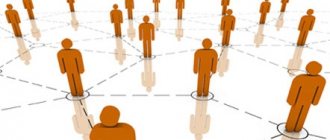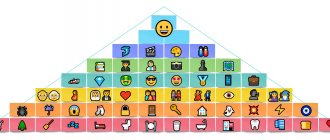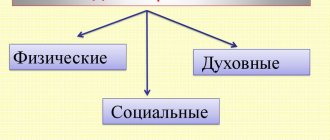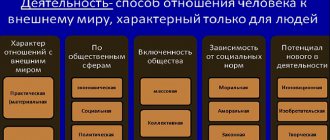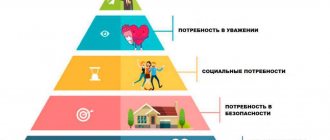Existence needs usually include physiological and safety. We believe that the needs of belonging should also be classified as this type. This is determined by the fact that a person cannot exist for any long time outside of any group (in particular, a family).
The following main levels of satisfying the needs of existence can be distinguished: 1) minimal, 2) basic, 3) luxury level.
The minimum level of satisfaction of the needs of existence ensures human survival.
The basic (normal) level provides the opportunity for the emergence of significant intellectual and spiritual needs. This level can be determined both subjectively and objectively. In the first case, the criterion for achieving the basic level is the time that a person is occupied with thoughts about meeting the needs for food, clothing, housing and security. It is advisable to assume that this time should not exceed half of the waking time. An objective assessment of the basic level can be the consumer budget, which experts consider necessary for various types of activities. In particular, the work of miners is among the most intense and dangerous. Therefore, the costs of food and rest for miners are objectively higher than for office personnel.
The level of luxury is proposed to be considered one in which the satisfaction of the needs of existence above the basic level becomes an end in itself and/or a means of demonstrating a high social status. At the level of luxury, a person “lives to eat, not eats to live.” Characteristics of an appropriate lifestyle are available in the works of A. Marshall, T. Veblen and many other authors.
Thus, Marshall has the following statements: “Laws against luxury have been in vain, but it would be a great achievement if the moral spirit of society could induce people to avoid all forms of boasting of individual wealth.” “...The world would be much more perfect if everyone bought fewer and simpler things, tried to choose them from the point of view of their true beauty; ...to consider the effect upon the general welfare of the manner in which each individual spends his income is one of the most important tasks of the practical application of economics to the way of life of men.”
For most people, the level of satisfaction of physiological needs significantly affects the structure of intellectual, social and spiritual needs. At the same time, it has been known since ancient times that the less a person is focused on material wealth, the more freedom he has from life’s circumstances and the powers that be. All great philosophers and religious figures - those who are commonly called Teachers of humanity - called for a reasonable limitation of physiological needs.
Thus, after achieving the basic level of satisfying the needs of existence, the needs to achieve life goals are formed, which, it is advisable to differentiate into four groups: 1) material benefits for the individual and family; 2) power and glory; 3) knowledge and creativity; 4) spiritual improvement.
Depending on individual inclinations, abilities and aspirations, in some people, after achieving the basic level of satisfaction of the needs of existence, the desire to maximize the consumption of material goods will dominate; for others - to power and glory; for others - to knowledge and creativity; for others - to spiritual improvement.
The structure of human needs is highly individual, which must be recognized in every attempt to understand someone's motivation. The relative importance of specific needs changes over time as individuals' commitments and interests change. Thus, for young people or individuals whose partners have high incomes, security needs come last. In addition, human needs often conflict.
The process of transforming human needs into behavior is no less individual. For example, an individual with a high need for responsibility or advancement will satisfy this need by obtaining a transfer to another department. And someone will decide to change their occupation.
What are needs?
Need is an internal feeling of need for certain resources, circumstances or actions. Of the entire animal world, humans have the widest range of needs: from mundane physiological to sublime spiritual. Needs include all material and intangible resources, actions, circumstances and other factors necessary for a person to feel satisfied or happy.
Human needs
appear as follows:
- An unmet need is usually associated with a feeling of discomfort, anxiety, melancholy and other negative emotions.
- Satisfaction of a need is accompanied by positive emotions (both directly at the moment of its satisfaction, and when realizing that it has already been satisfied).
- There is a fixation on the subject of need. A person’s attention involuntarily concentrates on what he lacks. When we get hungry, we begin to more sensitively detect appetizing smells, and a lonely person in any circumstances looks for reasons to meet a potential “soul mate.”
Also, human needs are characterized by the following features:
- people need much more to achieve a state of satisfaction than other species;
- with age, the number of needs increases, their priorities change (a child needs much less to be happy than an adult, and for older people social and spiritual values become much more important);
- there is a completely unambiguous hierarchy of needs, and those that are of great importance can “drown out” the less important ones.
Needs are the most important motivator that forces us to act and move forward. The most basic of them force us to work to ensure our existence, and the higher ones stimulate us to development, improvement and self-actualization. All existing achievements of mankind, including inventions, scientific theories, objects of art, musical and literary works, were created under the influence of human needs.
1.4. Motivation through needs
Because needs motivate people to want to satisfy them, managers must create situations that allow people to feel that they can satisfy their needs through the type of behavior that leads to the achievement of organizational goals.[1]
Fig.1. A simplified model of behavioral motivation through needs
The complexity of motivation through needs lies in the fact that people's characters are a combination of very different traits and that there is a huge variety of specific human needs, those goals that, in the understanding of each person, lead to the satisfaction of his needs, as well as types of behavior in achieving these goals.
Analyzing this problem, Stephon Carroll and Henry Tosi about
Work context is another determinant of motivation. We will not be able to correctly interpret the actions of individuals if we consider them outside the current and historical contexts, attitudes towards them and their interpretation by people. It is legitimate to highlight the following factors: The work itself (how interesting, varied and associated with responsibility it is); Organization (management, career and promotion, remuneration systems); External environment (for example, opportunities for obtaining another job). These and other internal factors influence human behavior.[2]
Fig.2. Human needs in context is a situational concept.
2. THEORIES OF HUMAN NEEDS AND ACTIVITY MOTIVATION
To effectively implement motivation, a modern leader needs to deeply understand and distinguish the entire range of individual needs, their place in the motivation process, their hierarchy and interconnection. This work is devoted to highlighting this issue. As part of the consideration of the problem, the basic principles and comparison of the substantive theories of motivation of Abraham Maslow, Clayton Alderfer, David McClelland, Frederick Herzberg are reflected here.
Motivation, in an organizational context, is the process by which a manager encourages other people to work towards achieving organizational goals, thereby satisfying their personal wants and needs.[3] Even if employees appear to be working only to achieve the overall goals of the organization, they still behave this way because they are confident that this is the best way to achieve their own goals.
Motivation, as one of the methods of the personnel management function, is an integral part of the management process.[4]
There are many ways to improve the quality of your work. For example, many regulations may prohibit production (such as requiring equipment to be monitored for contamination and occupational safety). Worker productivity could also be increased through investment in more modern equipment, such as assembly line robots or word processors for secretaries. This is, of course, useful, although it is only part of the solution since virtually all maintenance and production activities depend on humans. Even in the most automated auto assembly plants, for example those with few employees, poor employee attitudes and sabotage can seriously reduce productivity. And in the field of service, this is a subject of special attention.
Another way to improve productivity and performance is to improve human behavior at work through the application of modern resource management concepts and techniques. They have proven to be most effective in improving employee performance of their duties.
Thus, the task of the manager, who must motivate workers, is to provide them with the opportunity to satisfy their personal needs in exchange for quality work.
The term "need satisfaction" reflects the positive feelings of relief and well-being that a person feels when a desire is fulfilled.[5]
Practical management is based on certain theories of motivation, which can be divided into two groups. Content theories try to find out the reasons for this or that human behavior. They are often called "need theories." Process theories focus on the question of how this or that type of behavior arises, what guides, supports and stops it.
Motivation, considered as a process, can theoretically be represented in the form of six successive stages.
Naturally, such a consideration of the process is rather conditional, since in real life there is no such clear delineation of stages and there are no separate processes of motivation. However, to understand how the motivation process unfolds, what its logic and components are, the model below may be acceptable and useful.
1. The first stage is the emergence of needs. The need manifests itself in the form that a person begins to feel that he is missing something. It appears at a specific time and begins to “demand” from a person to find an opportunity and take some steps to eliminate it. Needs can be very different.
The second stage is finding ways to eliminate the need. Once a need has arisen and creates problems for a person, he begins to look for opportunities to eliminate it: satisfy, suppress, not notice. There is a need to do something, to undertake something.
The third stage is determining the goals (directions) of action. A person fixes what and by what means he must do, what to achieve, what to receive in order to eliminate the need. At this stage, four points are linked:
what should I get to eliminate the need;
what should I do to get what I want;
to what extent can I achieve what I want;
the extent to which what I can obtain can eliminate the need.
The fourth stage is the implementation of action. At this stage, a person expends effort in order to carry out actions that should ultimately provide him with the opportunity to obtain something in order to eliminate the need. Since the work process has the opposite effect on motivation, adjustments to goals can occur at this stage.
The fifth stage is receiving a reward for performing an action. Having done some work, a person either directly receives something that he can use to eliminate a need, or something that he can exchange for an object he desires. At this stage, it becomes clear to what extent the implementation of actions gave the desired result. Depending on this, there is either a weakening, preservation, or strengthening of motivation to action.
The sixth stage is the elimination of need. Depending on the degree of relief of tension caused by the need, as well as on whether the elimination of the need causes a weakening or strengthening of motivation for activity, the person either stops the activity before a new need arises, or continues to look for opportunities and take actions to eliminate the need.
Motivation theories are based on various assumptions about the factors that influence people's efforts and performance in an organization. E. Schein described four models of motivation, which assume that people have different needs and goals, and therefore will be motivated to do their work by different types of rewards and incentives. Thus, the focus is on the individual and his needs.
Classification of human needs
In psychology, all human needs are usually divided into three groups. This classification is quite unambiguous, since each group has very specific and obvious criteria. Let's look at each of them in detail.
Biological needs
This category includes basic needs aimed at survival, achieving physical comfort and procreation. It includes:
- delicious food (taste is important to determine freshness and nutritional value);
- clean water to quench thirst;
- comfortable living conditions;
- security and confidence in your future;
- satisfaction of sexual needs.
The listed aspirations are present in all living beings. They were formed evolutionarily to ensure the survival of the population. Essentially, they are all mechanisms that allow a person (or other creature) to survive and achieve “reproductive success” (produce offspring and ensure their survival in the future).
Social needs
Since man is a social being, he has a number of instinctive aspirations aimed at increasing his own importance in society or his group. The most illustrative examples are:
- Self-identification.
A person associates himself with his social group, while striving to recognize himself as an individual with special personal and other qualities. - Self-affirmation.
It is important for any person to be proud of their own actions and achievements, as well as to feel respect from others. - Altruism and passionarity.
Most of us derive pleasure from doing things that benefit other people or society as a whole. At the same time, self-esteem grows even if our contribution goes unnoticed by others, since for an altruist the act itself is important, and not the approval of others.
Spiritual Needs
There is a system of universal spiritual values that most people share in one way or another. We strive for moral and spiritual growth, appreciate beauty, grace of form and harmony, enjoy contemplating objects of art and listening to beautiful music. At the same time, each person has his own taste, so we all like different styles in music and styles in painting. In addition, priorities of spiritual values change throughout life.
Spiritual needs include:
- Self-actualization.
Obtaining new knowledge, expanding the range of interests and hobbies, professional growth, advanced training - these are all natural aspirations for a person who is currently not concerned with satisfying basic biological needs. - Self improvement.
As we grow up, we understand that we like to become better not in order to please someone, but simply to feel our progress. We give up smoking and alcohol, take up sports, begin to maintain a daily routine and control our stress levels. We just like to think that we're getting a little better every day. - Romantic love.
This point could be considered a manifestation of the reproductive instinct, but for us it is something much more. It is very important for us to have a loved one nearby who inspires us and gives us not only sexual but also emotional pleasure.
Spiritual needs, unlike biological and social ones, are present only in humans. Moreover, their list is not just extensive, but almost endless, since each person finds some of his own hobbies that do not have to be shared with someone else. Some people like fishing, some prefer knitting, some watch TV series, some reread The Little Prince for the hundredth time, some adore the sound of pouring rain outside the window, and some experience peace from the echoing the croaking of frogs in a nearby pond.
Maslow's pyramid of needs
Many scientists and researchers have resorted to classification of needs. But Abraham Maslow achieved the greatest success. He was able to distribute all the needs into seven levels, from the lowest (basic) to the highest.
The advantage of this classification of human needs is as follows. A person must go through the lower levels in order for him to develop needs for the higher ones. If they are not satisfied or partially satisfied, he will never reach level 6 or 7, and he will not have other needs.
What kind of pyramid is this?
- It is based on physiological needs : food, sleep, sex, etc. In order to live normally and feel good, a person must eat, breathe, sleep, etc. normally.
- At the second stage is safety . A person has a need for security and comfort. For example, if a person is driven by hunger, then he may commit a crime - robbery, theft. He doesn’t care about the second stage, that is, security. If basic needs are satisfied, he will think more about his safety and not about food.
- At the third stage are social needs. When basic needs are satisfied, the individual feels safe, begins to build social connections, works with someone, takes care of someone.
- The fourth is the need for recognition and prestige. That is, a person wants to have weight in society, respect from other people, achieve certain results in order to be highly appreciated by people.
- The fifth stage is spiritual needs. If a person has satisfied previous needs, he is able to reveal his creative potential, understand himself and identify.
But there are two more levels that Maslow added later. So now the pyramid looks something like this.
- The first stage is physiological needs.
- The second stage is the need for security.
- The third stage is the need for love, in order to love oneself and be loved.
- The fourth stage is the need for respect and recognition in society.
- The fifth stage is the need for knowledge and obtaining new information.
- The sixth stage is aesthetic needs, the search for harmony and beauty.
- The seventh stage is the need for self-actualization, when it is important for a person to realize his ideas and answer the question: who am I and why do I live?
Scientific theories about human needs
Abraham Maslow's theory
This is the most famous classification of human needs, everyone who has at least once been interested in self-development knows about it. This concept was proposed and developed by the American psychologist Abraham Maslow in a number of his works on motivation. He sorted all human needs by elevation: from lower (biological) to higher (spiritual). Due to the characteristic form of the schematic image, this classification was called “Maslow’s Pyramid”.
The author himself identified 5 levels in his classification:
1. Physiological needs.
In this group he included food, water, sleep, sexual satisfaction - all the basic needs of our body.
2. Safety.
When all physiological needs are satisfied, a person seeks to protect himself and his family. This group includes not only good protection from predators and other dangers, but also confidence in stability and order.
3. Love and belonging.
Here we are talking about good relationships, love, friendship, belonging to a certain social group.
4. Respect and recognition.
If a person is confident in his own well-being in all areas included in the first three levels of the pyramid, he has a strong need for respect and recognition. Here we are not talking about the banal “You respect me, no?!”, but about real respect for actions and achievements.
5. Self-actualization.
Abraham Maslow included in this group self-development, self-education and other ways of working on oneself, one’s skills, knowledge and abilities.
If you look closely at the 5 tiers of Maslow’s pyramid, you will notice that the first two are biological, the third and fourth are social and partially spiritual, and the fifth are purely spiritual needs.
One of the most important statements of Maslow's theory is that each level becomes important only if all the needs located at lower levels are fully satisfied. For example, hunger or unfulfilled sexual instinct (first level) makes a person forget about caution and safety (second level).
If we compare lower needs with higher ones, we can notice several characteristic differences:
- higher needs appear much later (they first appear in adolescence, after which they develop throughout life);
- higher needs are perceived by most people as less important, “optional”;
- the higher the need is in the hierarchy, the easier it is to postpone its implementation to the future in order to solve more pressing problems;
- people living at higher levels of Maslow's pyramid tend to have good health (partly because they take care of it), experience less stress and sleep better;
- a person receives much more joy and pleasure from satisfying higher needs.
The original concept proposed by Abraham Maslow had 5 tiers, which we discussed above. Later, many authors took liberties in its interpretation and introduced additions, increasing the number of levels. Therefore, do not be surprised if you see different variations of the pyramid with 7 or 10 tiers. In any case, the basic concept of Maslow's theory remains.
Read more about Maslow's Pyramid of Needs in this article.
Alderfer's ERG theory
American professor Clayton Alderfer proposed an alternative theory of motivation. It does not contradict Maslow’s theory, but it uses its own classification of needs, which includes 3 groups (the abbreviation ERG is derived from their names):
- Existence (existence, life).
- Relatedness (relationships, communication).
- Growth (personal growth, development).
As you might guess, the first group is represented by physiological needs, the second by social, and the third by spiritual. At the same time, Clayton Alderfer showed that the relationship between these groups is somewhat more complex than Maslow described (priorities are influenced not only by the fact of satisfaction itself, but also by the degree of satisfaction).
In addition, he noticed that dissatisfaction with higher needs increases the desire to satisfy lower ones. For example, it is known that during any crisis the revenue of confectionery stores increases sharply. This is explained by the fact that people, losing a sense of stability, begin to buy more sweets (even those who do not like them at all and usually do not buy them).
Fromm's theory
German psychologist and sociologist Erich Fromm considered social interaction to be a key factor influencing the human psyche. This was reflected in his theory of needs. He proposed a five-point hierarchical scheme:
- Interpersonal connections (love, friendship).
- Creativity (any creative activity, regardless of type).
- Feeling of strong and deep roots (stability).
- Search for the ideal and assimilation to it (self-improvement).
- Knowledge of the world (spiritual improvement).
As one of the founders of neo-Freudianism, Fromm believed that our basic needs are controlled by the unconscious. But since the unconscious often encounters such obstacles as taboos, stereotypes, logic, rationality, etc., needs remain unfulfilled.
McClelland's theory of acquired needs
American writer and psychologist David McClelland proposed his theory of motivation. He believed that all needs are formed in childhood. At the same time, he divided them into three groups, explaining the mechanism of formation of each of them:
- Involvement.
This need arises in children who were engaged in collective activities and played team games. As a result, even in adulthood, they feel the need to be part of a group, to participate in a socially significant project or movement. - Power.
If in childhood one way or another is encouraged to control other children, in adulthood such a person needs a sense of power. Also, this need can be formed under the influence of the family atmosphere. - Success.
If a child is taught to be independent, to achieve something, to receive prizes and certificates, as an adult he will also need success.
Types and purposes of means to meet needs
Products act as means of satisfying needs. We can talk about a broad and narrow definition of the concept of “product”. In a broad sense, all means of satisfying needs offered in the market and its various segments are classified as goods. Historically, it has developed that services, money, securities, labor resources, information, ideas, which are specific goods, are usually identified as independent types of means of satisfying needs. Goods usually include only material products (“things”) offered on the market, i.e. in the narrow sense of this term. However, when considering the characteristics of other means of satisfying needs, one can see that they have much in common with goods.
Goods in the form of physical objects include raw materials, supplies, semi-finished products, components and finished products. They are able to satisfy the most diverse needs of individual, industrial and managerial consumers, relating to all the previously listed types and varieties of needs. Thus, most food products satisfy physiological and mental (organoleptic) needs. However, prestigious goods (caviar, meat and fish gastronomy) also satisfy social needs. Tobacco products satisfy mainly mental and sometimes social needs (as a way of communication). Non-food products satisfy physiological and social needs (clothing and footwear), mental, intellectual and spiritual needs (cultural, household, book and similar goods).
Services, like goods, can simultaneously satisfy one or two, or less often three, types and/or varieties of needs. Thus, the food service satisfies physiological, social and mental (organoleptic, ergonomic) needs, and the retail service satisfies only the last two types of needs. Medical, health, sports, tourism and similar services are designed to satisfy recreational and safety needs.
Technologies are designed to produce goods and services that will satisfy a variety of individual and societal needs. However, the technologies themselves directly satisfy social needs (economic, labor and technological, necessary for the life support of society as a whole, industrial and individual consumers). . Technologies act as a means to meet the needs of industrial consumers in the capital goods market.
Money and securities fulfill a social purpose and, accordingly, satisfy social needs (prestigious, economic, life support for society and individual consumers). This is explained by the peculiarity of money and securities that perform the functions of an equivalent of goods and services in commodity-money exchange. It is money and other financial means that replace it (credit cards, bank checks, etc.) that help transform needs into demand. In addition, money and securities serve as a means of accumulating and satisfying predicted and deferred needs (for example, for large purchases, vacations, ensuring future expenses).
Labor resources (management, management, production and service personnel) are a means of satisfying needs in the labor market. Since the objects of labor activity of management and personnel are tangible and intangible products, services, technological processes, as well as lower-level personnel, their professional activities require competence in certain areas. As a result, educational and information needs arise related to the training and development of personnel and management. Users of labor resources in the labor market are industrial consumers (manufacturers or service providers), state and local governments, public associations and organizations, as well as individual entrepreneurs. Labor resources (management and personnel of the organization) in the process of work create products, which all or most of them become goods, or provide services. Thus, labor resources are involved in meeting the needs of various consumers, including individual ones.
Information directly or indirectly satisfies the needs of all categories of consumers: public and individual in the market of information products, services and technologies (for example, the development and sale of computer programs). Information that is not related to a specific object is meaningless and of no interest. Information is always about something or someone: about goods, services, money, securities, politicians, athletes, etc. It is a kind of multifunctional product or service: it functions as a means of not only satisfying informational, educational and spiritual needs, but also the promotion of goods to the market, as well as a means of communication that allows them to generate demand. Information performs these functions due to its main purpose - satisfying intellectual, in particular information, needs. Thanks to this, information ensures that all other types of means of satisfying needs are communicated to the consumer.
Ideas satisfy many needs. They underlie the creation of all goods, services, etc. For example, the computer appeared as a result of the idea of the need to create a machine to increase the speed and quality of information processing. The development of the restaurant business is based on the idea of the need to save consumers’ time in preparing food, and the development of entertainment establishments (theaters, sports organizations, etc.) is based on the organization of leisure for consumers. Industrial consumers are more interested in buying ideas, since they allow them to launch new goods and services on the market based on them. At the same time, all categories of consumers, when purchasing goods and services, simultaneously buy the ideas embedded in them.
Product (product and its characteristics);
1.Product offer.
The product offering has consumer value and cost. Consumer value allows you to satisfy the needs of customers and is a combination of such characteristics assortment, quality, quantity, etc. In addition, a product offering as an object of purchase and sale may have a certain value. Price helps create consumer preferences and is a measure of the consumer value of a product offering.
The product offering can be viewed in terms of five levels:
1. Key value is the main service (Advantage) that the buyer purchases.
A person who comes to a bakery for bread buys food that can satisfy his hunger. With the same success he could buy potatoes, meat or other food products.
The task of a market worker is to identify the needs hidden behind any product and sell not the properties of this product, but the benefits from it ( better satisfaction of needs, lower price, more convenient service
)
2. The main product is a product offered for sale with a set of certain characteristics. The main product can have five characteristics:
· Quality level
· Set of properties
· Specific design
· Brand name
· Specific design
The task of enterprises is to provide the product with all the necessary characteristics so that the consumer can compare them with the parameters of their needs and decide whether the product will satisfy it.
3. Expected product - a set of characteristic features and conditions that the consumer usually expects and to which the consumer usually expects and to which he usually agrees when purchasing this product. When purchasing bread, a person expects freshness, a pleasant aroma, a certain composition indicated on the package.
The task of marketers is to identify all consumer expectations and determine whether the product has them or not; if not, then the product must be improved.
4. An improved product meets needs beyond normal expectations. The main goal is to identify unconscious needs, predict their changes and release them to the market before competitors.
For example, bread is cut into pieces and packed in vacuum packaging. The magazines come with a disc as an attachment, etc.
· Any improvement requires additional costs, therefore, you need to find out whether buyers are ready to pay for them
· An improved product after some time turns into the expected one, so the market offer should be constantly improved.
· Since improved products are more expensive, there will always be competitors who focus on the main product, intended for consumers in need of a cheap product.
5. Potential product - associated with those improvements and transformations that an existing product may undergo in the future.
